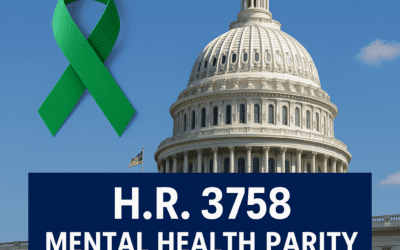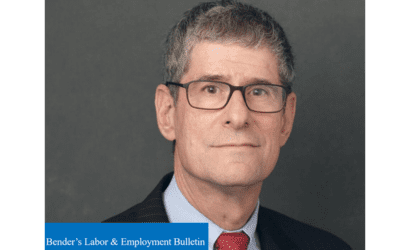Today’s column discusses Patton v. MFS/Sun Life Financial Distributors Inc., 2007 U.S.App.LEXIS 5715, an opinion issued by the 7th U.S. Circuit Court of Appeals on March 12.
Michael Patton, a truck driver, became disabled from driving a truck on account of a knee injury. Sun Life initially approved the claim, but benefits were discontinued after one year based on a suggestion that Patton was released by his physician to undergo paramedic training and his doctor’s opinion that he could not work, then that he could work, and finally, that he was unable to work. The district court limited its review to the claim record and refused to allow discovery or additional evidence, leading to the entry of summary judgment in Sun Life’s favor. The Court of Appeals reversed.
The first issue addressed by the court was the standard of review. The district court initially noted the policy stated ”proof [of any disability claim] must be satisfactory to Sun Life.” Citing Donato v. Metropolitan Life Insurance Co., 19 F.3d 375, 377 (7th Cir. 1994), which held that such language triggered a deferential review standard, the lower court accepted Sun Life’s argument that the arbitrary and capricious standard of review applied. However, Donato was overturned on Sept. 20, 2005, by Diaz v. Prudential Insurance Co. of America, 424 F.3d 635 (7th Cir. 2005). Thus, a deferential standard of review was no longer appropriate. Because the case was still active in the district court at that point, the plaintiff argued that the de novo standard of review had to be applied and that standard allowed the record to be opened with additional discovery. Although the district court agreed that the de novo standard might be appropriate, the court disallowed additional discovery and subsequently granted Sun Life’s motion for summary judgment based on the existing claim record.
Patton appealed both the summary judgment ruling and the district court’s denial of discovery. Addressing the summary judgment issue first, the court expressed the view that appellate courts generally remand for trial when a determination is made that summary judgment was inappropriate; however, the rule is often different in ERISA cases where courts have found the plaintiff ”has no right to a jury trial and unusually limited abilities to introduce evidence.” (Citing Mathews v. Sears Pension Plan, 144 F.3d 461, 468 (7th Cir. 1998)). Hence, the court explained: ”If on a certain record a district court believes a party is entitled to summary judgment, then the same court, if required to conduct a bench trial on that same record, will probably decide the case for that same party. Consequently, if we think that a district court granted summary judgment despite the existence of genuine issues of material fact, but know that no new evidence will be presented at trial on remand, we can in most (though not necessarily all) situations know with certainty that remand would be an unwarranted ’empty formality.'”
In footnote 2 the court explained, ”In some situations, the winner of a bench trial might be uncertain even though no new evidence will be presented. For instance, an appellate opinion might illumine some aspect of the record that the district court improperly ignored, in which case the remand would be analogous to remanding agency action for further consideration or explanation.”
The court said other circuits have said summary judgment is not truly summary judgment in ERISA cases that have been characterized as claims involving a review of a record.
In footnote 3 of its opinion, the 7th Circuit disagreed with such cases, stating: ”We do not apply this potentially misleading standard for ‘summary judgment,’ but instead apply the normal rule: de novo review, with judgment appropriate if there is no genuine issue of material fact. Fed. R. Civ. P. 56(c)…. Those who wish to ensure that a judgment is treated with the deference due the result of a bench trial are advised to eschew Rule 56 and stick to Rule 52(a).”
Despite the lower court’s recognition of the appropriateness of a de novo standard of review, Sun Life argued that the policy mandated review to determine whether the denial of benefits was arbitrary and capricious. However, the court said, ”ERISA contract law is shaped by ERISA’s goal of providing uniform remedies to employees.”
Hence, ”Absent clear language to the contrary, plans are read to provide for searching judicial review of benefits determinations: plenary review of the administrator’s interpretation of the facts and plan … fortified by the district court’s discretionary authority to hear evidence that was not presented in the administrative process. The employee thus presumptively has a right to an ‘informed and independent judgment’ on his claim for benefits – informed by evidence as the court thinks necessary, and fully independent of the plan administrator’s findings and reasoning.”
While that presumption can be overcome, the 7th Circuit reiterated that to do so, there must be ”clear language to the contrary,” citing the ”safe harbor” language first articulated in Herzberger v. Standard Ins. Co., 205 F.3d 327, 331 (7th Cir. 2000): ”Benefits under this plan will be paid only if the plan administrator decides in his discretion that the applicant is entitled to them.”
Again, Sun Life tried to assert the policy requirement that proof ”must be satisfactory to Sun Life” furnished a basis for applying the arbitrary and capricious standard of review, but as in Herzberger andDiaz, the court responded by pointing out, ”Every plan will require employees to prove they are entitled to benefits before receiving them, and provisions that merely implement that basic requirement do not warn employees of broad administrative discretion and limited review.” Thus, the de novo standard was applied and the court framed the issue as deeming summary judgment appropriate ”only if no reasonable fact-finder could conclude” that plaintiff was unable to perform his occupation during the relevant time period.
In examining the evidence presented, the court acknowledged Sun Life’s argument that a conclusory medical opinion without any rationale cannot create a genuine issue of material fact. However, while finding some contradiction in the treating doctor’s opinions, the court determined that the evidence contained a detailed explanation as to the basis for the doctor’s diagnosis, restrictions, limitations and prognosis. Thus, the doctor’s opinions were characterized as ”poison to [Sun Life’s] summary judgment hopes.” Although Sun Life pointed to inconsistencies in later reports, the court determined that a reasonable fact-finder would not be able to conclude that later checkoff forms were sufficient to torpedo the plaintiff’s claim altogether and the contradictions are more properly issues relating to the weight to be given the reports that allegedly undermined the ongoing certification of Patton’s disability. Moreover, while, as a general rule, a party cannot defeat summary judgment with an affidavit contradicting deposition testimony, there may be legitimate reasons for the change such as confusing deposition questions, lapse of memory or ambiguous or incomplete testimony; thus, ”a court must examine the particular circumstances of a change in testimony to see whether it is plainly incredible or merely creates a credibility issue for the jury.”
Because the doctor’s letters were confusing, the court found that a fact-finder could conclude that the one outlying opinion that Patton could drive was a mistake and that the doctor’s real opinion was that he was unable to work – and that the inconsistency may not have been explainable earlier because ”Patton lacked the ability to compel [the doctor’s] testimony or cross-examine him” during the ERISA pre-suit claim proceedings. The court also dismissed Sun Life’s claim that the treating doctor’s release of his patient to resume EMT training contradicted his opinion by pointing out the doctor ”is an orthopedic surgeon, not a rehabilitation specialist.” Thus, since there was no indication that the doctor knew the specific duties at issue, while a reasonable fact-finder could reach a conclusion consistent with Sun Life’s findings, such a conclusion is not compelled. Consequently, summary judgment was inappropriate.
The court then turned to the motion to reopen discovery and agreed with Patton that additional evidence was necessary for the court to ”make an informed and independent judgment.” (citing Casey v. Uddeholm Corp., 32 F.3d 1094, 1099 (7th Cir. 1994)). Although the court’s review of the district court’s denial of discovery for abuse of discretion, the court of appeals found that the district court had abused its discretion. The basis of the 7th Circuit’s ruling inCasey was the 4th Circuit’s opinion in Quisenberry v. Life Ins. Co. of North America, 987 F.2d 1017 (4th Cir. 1993), which enumerated circumstances under which additional evidence may be introduced. Because the district court failed to furnish an adequate explanation for disallowing discovery, and based on significant gaps in the evidence, the Court of Appeals concluded that the denial of discovery was reversible error. The court also set forth the following rule: ”A court should not automatically admit new evidence whenever it would help to reach an accurate decision. Any relevant, probative evidence increases the likelihood of an accurate decision, but always at the price of increased cost, both in the form of more money and additional time. See Quesinberry, 987 F.2d at 1023, citing Perry v. Simplicity Engineering, 900 F.3d 963, 966-67 (6th Cir. 1990). The record calls for additional evidence only where the benefits of increased accuracy exceed the costs, a balance familiar to the district court. Cf. Fed. R. Evid. 403; White v. United States, 148 F.3d 787, 791 (7th Cir. 1998); United States v. Pulido, 69 F.3d 192, 204 (7th Cir. 1995).”
Here, the court determined ”that a relatively slight expenditure to depose Dr. Ambrose will result in a unusually high payoff in increased accuracy, because the case hinges in part on factual determinations which, given the obscure evidence in the administrative record, are little better than guesses.” Accordingly, expansion of the record to explain the inconsistencies was warranted and the court ruled that on remand, the court should consider evidence from the treating doctor and consider receiving other evidence.
The 7th Circuit went a long way toward straightening out a confusing situation in this ruling.
However, while recognizing differences in civil procedure between ERISA cases and other federal civil actions, the court might also want to question why such distinctions exist and the basis for such distinctions. Unfortunately, starting with a 6th Circuit ruling, Perry v. Simplicity Eng’g, 900 F.2d 963, 967 (1990), many courts have misapplied the ERISA statutory history cited in that ruling (ERISA was intended to provide ”a method for workers and beneficiaries to resolve disputes over benefits inexpensively and expeditiously”) to justify a quasi-administrative law paradigm in adjudicating ERISA cases without examining the Senate Report from which that quote was derived. The quotation can be traced to Senate Report 93-383 accompanying S.1179, a predecessor to the bill that eventually became the ERISA law. The draft bill afforded pension claimants the opportunity to pursue a grievance or arbitration proceeding before the Secretary of Labor; and the report refers to such a proceeding as providing ”the opportunity to resolve any controversy over retirement benefits under qualified plans in an inexpensive and expeditious manner…. Accordingly, the committee has decided to provide that controversies as to retirement benefits are to be heard by the Department of Labor.” S.Rep. 93-383, reprinted in 1974 U.S. Code Cong. & Admin. News 5000.
That provision was dropped from the final bill, though; and nowhere in the ERISA statute is there any provision limiting the manner in which the courts are to resolve civil actions brought by welfare plan participants pursuant to 29 U.S.C. section 1132(a). On the contrary, the Conference Report explained that ERISA civil actions ”are to be regarded as arising under the laws of the United States in similar fashion to those brought under section 301 of the Labor-Management Relations Act of 1947.” H.R. Conf. Rep. 93-1280, 93d Cong., 2d Sess. 327 (1974). Such proceedings are plenary and even encompass trials before juries. See, Chauffeurs, Teamsters & Helpers, Local No. 391 v. Terry.
This article was initially published in the Chicago Daily Law Bulletin.






